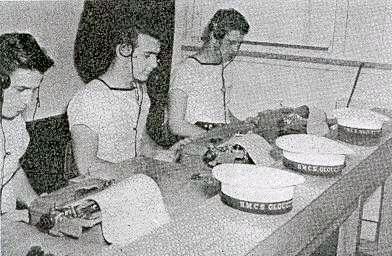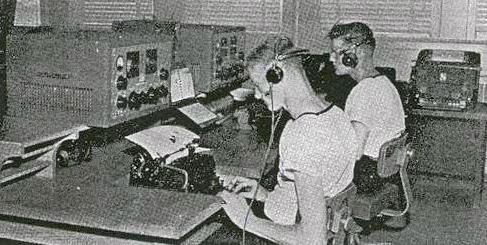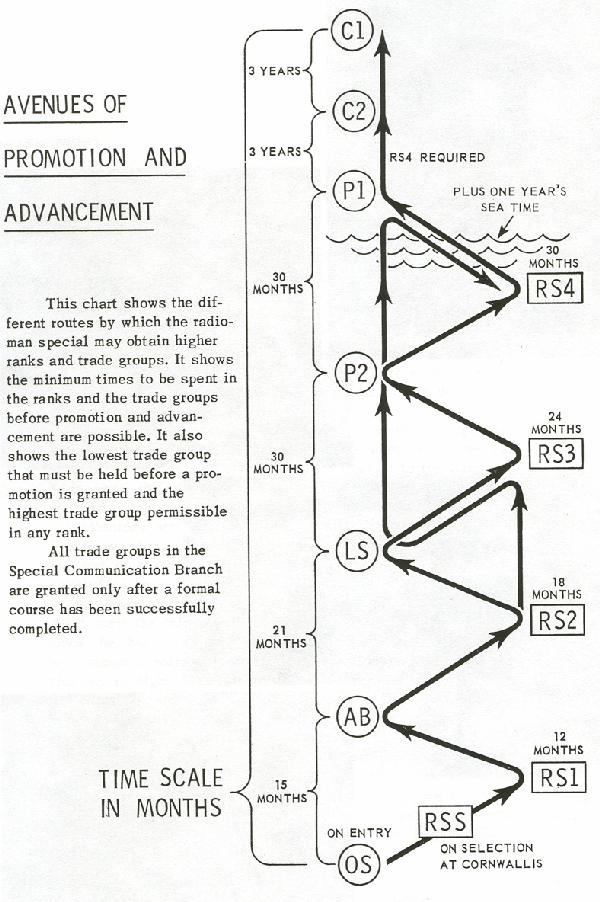"The basic course which the trainee faces in GLOUCESTER in one which prepares him towards qualifying for his first trade group. The course lasts twenty-two weeks; during it, the trainee learns to read the Morse Code at twenty-two words per minute and to type at thirty words per minute. He also learns communication procedures used in the handling of messages, and is taught how to operate and basically maintain many pieces of radio equipment. At different times he is subjected to practical and academic examinations which are designed to evaluate his progress and enable his instructors to help him should he be encountering difficulties.
This course is not particularly difficult, but in order to complete it successfully, the trainee is required to apply himself and absorb the information given him. Classrooms and equipment are available in the evenings, and an instructor is on duty to assist the student. The man-under-training may make use of these facilities voluntarily, but if his course instructor finds it necessary, extra study or Morse and typing practice may be assigned compulsorily".
David Smith recalls his early days at Gloucester. "In 1960, we all learned
Morse from tapes routed through a piece of equipment whose speed was adjustable
by a rotating knob. The signal was routed to each "bay" where we
wore a set of headphones - pretty rudimentary ones in those days.
In the initial stages, we had to listen to the code, and then type the
letters using a typewriter. For me, having learned touch typing before
joining the RCN was a real bonus. The sailors who did not touch-type had
to listen for the code and then hunt for the key on the
typewriter - double whammy.
I distinctly recall certain speeds being a real challenge for the whole class and the solution tendered by our instructor was to skip the offending speed. For instance, 12 wpm was of of those "plateau" speeds so instead of sticking with 12 wpm, he would advance to the speed 13 or 14 wpm. It was strange because so many students in the class, if not all experienced the same problem. When done, we qualified at 22 wpm. This automated morse did not prepare us well for work "in the field" since there was no noise or fading to contend with. As well, listening to code sent by "bugs" ( semi-automatic keys) was another world at the beginning since speeds would exceed 25 wpm at times. After months and years of copying Morse however, one became quite proficient at it
I had often wished I had been given training on sending Morse but as is now well known, we were mostly "listeners", not senders. There were those CS rates who were quite accomplished with a key however, especially speed keys and I was always in awe of some of those talents.
During the Morse training course, there were certain incremental speeds from the automated paper tape Morse sender that no one was happy with so instead of bumping up an increase of say, two words per minute, the instructor would oblige the entire class and move it up a bit faster which seemed to solve our problems. As any Morse operator will recall, it wasn't learning Morse that was difficult - one could learn the entire alphabet in a few days (or less) but simply learning to copy at 22 wpm and above. We were all suitably impressed when our instructor would demonstrate his Morse skills and copy at 35 wpm to show it could be done. To our untrained ears at that point in time, the tones seemed to merge into one long mess but time and practice took care of that.
I recall that during our training we copied Morse by "stick" (pencil)
and in particular we were even taught how to change our penmanship to create
distinctive letters (P's and R's for example). I still get handwriting
from former CS rates and this particular style of printing remains in evidence
- something we no doubt will carry to the grave (pencil optional)."
 |
| Learning to type Morse code by audio oscillator. (From the "Welcome To Gloucester" booklet) |
 |
| Off-the-air copy using Hammarlund SP-600 receivers. (From the "Welcome To Gloucester" booklet) |
Ray White also recalls his time at Gloucester. " My first instructor, in my Trade Group 2 class back in 1951 was none other than Gerry Burton, then a P2CS3. Morse training in those days consisted of SBXs (Standard Buzzer Exercises) being transmitted manually and automatically. The SBX was an official RCN format that consisted of a variable number of words in plain language English, a variable number of words in a “foreign” language. Often it t was French, although we did some Spanish and occasionally some Russian. This was followed by a variable number of letter code groups, usually 5-letter code, and then some figure code. The end of the SBX usually contained about 5 short chatter-type transmissions, sometimes using ACP124 procedure, sometimes using commercial merchant navy procedure in various languages. This format was basically the same in manual and automatic morse and was the format laid down by the Directorate of Naval Communications for all communication training throughout the Navy. It even had an official form with the usual CNS number on it
The automatic morse was sent by Wheatstone tape and transmitted to us by the same commercial equipment, used by maritime shore stations for the merchant fleet and also by the RCN, USN etc for their broadcasts. We did not use “buzzers” but rather code oscillators which could be routed to each trainees headphone connection.
This change to automatic International Morse produced a better than previous pass rate but at the price of leaving the new entry CS rates sadly lacking the ability to copy poor manual morse or Cyrillic characters using what were called “tiddly letters.
Incidentally, one of the best “fists” I have ever heard was Gerry Burton who instilled a sense of operating in an active environment. We enjoyed copying his manual SBXs".
ON GRADUATION
The booklet goes on to explain the expectations at graduation. "When
he has completed the basic course in GLOUCESTER, the Radioman Special is
drafted either to sea, or to one of three operational stations - either
Naval Radio Station, Aklavik, in the Northwest Territories, HMCS CHURCHILL
at Fort Churchill, Manitoba or to HMCS COVERDALE in Moncton, New Brunswick.
He then commences a three month on-the-job training period at the end of
which he is eligible to write his Trade Group One qualifying examinations.
After a period normally of two years, he may be drafted to other stations
such as Masset in the Queen Charlotte Islands, Frobisher Bay on Baffin
Island or Gander, Newfoundland. He may also be sent on exchange duties
with the United States Navy or be given a chance to specialize in various
skills at other Armed Forces schools. In short, there is an interesting
future ahead of the Radioman Special via a number of widely varying avenues".
 |
| Advancement path to higher ranks and trade groups. (From the "Welcome To Gloucester" booklet) |
MORSE CODE UPDATE
To address the issue of "speed plateauing" while learning Morse, today's amateur radio operators employ the Farnsworth method. Traditionally, reducing the speed of Morse code has been done by making everything take longer, i.e. both the sounds and the silent periods between them.
In the 'Farnsworth' method, the characters are sent at a faster speed, usually 18 wpm, but the spaces between the letters and words are increased to bring the overall speed down to the desired value. The advantage of this method is that your brain gets used to hearing the code sent at a fast speed, so when the overall speed is increased, the brain already knows the rhythm of the characters, it just has to recognize them slightly faster.
THE END OF CODE IN THE RCN
On September 1, 1993 all Morse Code operations ceased in the Royal Canadian Navy. To mark the occasion, the following clear text Morse message was sent by CFH (Halifax Radio) on August 31, 1993, on a frequency of 4255 KHz.
The call tape sent at 25 words per minute (wpm), droned on to lead up to the top of the hour...
VVV VVV VVV DE CFH CFH CFH C13L C13L C13L (repeated three more times). The call tape stopped, whereupon the following message was sent at a speed of approximately 10 wpm.
NAWS
C13L001
R
P312300Z AUG 93 312300Z AUG 93
FM MSAX MILL COVE
TO ALL SUBSCRIBERS C13L BT
UNCLAS
1. SEPTEMBER 1, 1993 HAVING BEEN DESIGNATED AS THE DATE ON WHICH REGULAR CW SERVICE CEASES IN THE CANADIAN NAVY, THIS IS THE FINAL OCCASION WHEN SPARKERS WILL HAVE THE OPPORTUNITY TO PUT THIS DYING ART TO USE2. FOR THOSE WHO CAN RECALL QUOTE BENS BEST BREAD UNQUOTE WILL ALWAYS BE A RYTHM ON THE TIPS OF THE FINGERS
3. AS WE ENTER INTO THIS NEW ERA, THE MEMBERS OF THE OPERATIONS DEPARTMENT AT MILL COVE WISH TO SAY ONE LAST TIME RR CUL OM QRU QRU
ARAnd the text sped up from 10 wpm to about 25 wpm for a final round on the call tape...
BT
AR
VVV VVV
VVV VVV VVV DE CFH CFH CFH C13L C13L C13LThe tape stopped, leaving only the background noise and a sadness in a Sparker's heart.
VVV VVV VVV DE CFH CFH CFH C13L C13L C13L
VVV VVV VVV DE CFH CFH CFH C13L N
References and Credits:
1) Welcome to Gloucester booklet Queen's Printer
, Ottawa, 1960.
2) David Smith <drdee(at)sympatico.ca>
3) Ray White <r.p.white(at)sympatico.ca>
4) Farnsworth method http://www.aa9pw.com/radio/learn_code.html
5) David Ring, N1EA